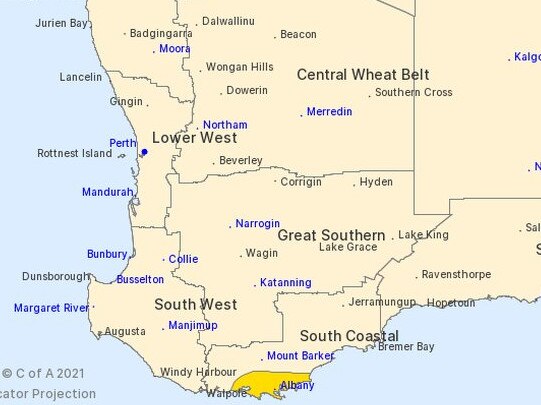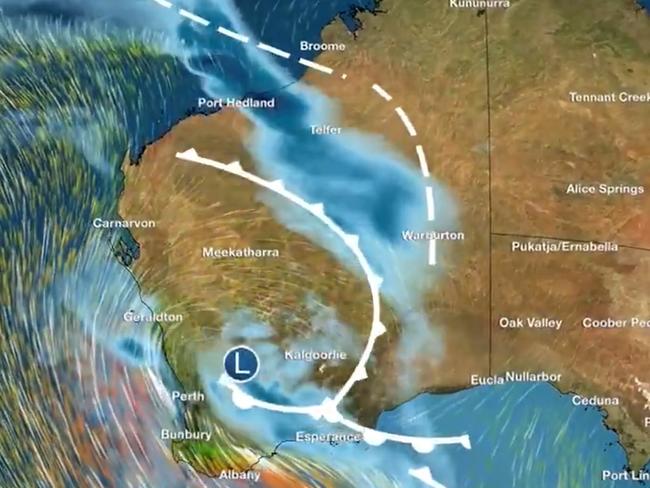Thousands of homes without power after storm damages National Anzac Centre and causes widespread flooding
More than 16,000 properties are without power after a fierce storm, while one iconic building important to the Anzacs has been severely damaged.

Albany Mayor Dennis Wellington was on a flight home to the coastal West Australian town during a fierce storm when the pilot realised there was no way to navigate the wild weather and safely land.
A decision was made to turn back to Perth, but Mr Wellington said it was a tough journey for the 28 people on-board the aircraft.
“We bounced all around,” he told NCA NewsWire on Monday.
“There was not a hell of a lot of control going on.”
Mr Wellington said he felt sick in his stomach during the worst of the turbulence.
“It was very quiet when all of that was going on,” he said.
“There were some very big sighs of relief when we landed back in Perth.”
Mr Wellington then got in a car and drove back to Albany – an almost five-hour drive – at 3am.

Rainfall is continuing to pour in the area but the worst of the storm is over, according to the Bureau of Meteorology.
About 16,800 properties remain without power, including 9000 homes.
Mr Wellington said some of the most significant damage was to Albany’s iconic National Anzac Centre, which opened in 2014 and is a major tourist attraction.
The award-winning, interactive, multimedia museum had part of its roof torn off in the storm.
Mr Wellington said authorities were trying to get the full extent of the damage assessed, but it was still too windy.
There is also some water damage inside the building.
“It will be out of action for a week at least,” the mayor estimated.
Mr Wellington said part of the railway line would also be closed for “quite some time”.
“Roads have been flooded like we’ve never seen in years,” he said.
The last time would have been during a cyclone in the 1980s, he estimated.

Emergency services have answered more than 100 calls for help since 6.30pm on Sunday, with damage reported from Albany to Denmark.
The number of calls for help are likely to increase during the day, and people are asked to be patient as SES volunteers respond on a priority basis.
“Our priority during the storm is responding to reported hazards to ensure the safety of the community and our crews,” electricity provider Western Power tweeted.
“All available crews have been deployed and we’ve had crews working through the night.
“Our network operations team is working to isolate damaged parts of the network and backfeed where possible to restore power where it is safe to do so.”
Our network operations team is working to isolate damaged parts of the network and backfeed where possible to restore power where it is safe to do so. Remember if you see any damage to the network, please stay eight metres clear and make the safe call immediately.
— Western Power (@westernpowerwa) June 21, 2021
A slow-moving trough brought heavy rainfall over the south coastal district, but the rainfall has been gradually easing as the trough moves east.
“Severe weather is no longer occurring in the south coastal district; however, gusty winds and areas of heavy rain should continue during the day and extend slowly east,” the Bureau of Meteorology said.
“Water levels may still be elevated in some rivers and streams, and there may be areas of flooding that are yet to subside.”

A wind gust of 96km/h was recorded at Albany Airport at 8.49pm on Sunday.
Some locations recorded rainfall up to 30mm per hour on Sunday night and early on Monday morning.
“It is likely that more intense rainfall rates occurred in the Albany area during Sunday evening, with significant flooding reported,” the bureau said.
The Department of Fire and Emergency Services warned some roads would be closed due to fallen trees and power lines as well as flooding.
People are urged to be careful on the roads and not drive into water of unknown depth and current.
The Denmark River has burst its banks. Now that’s a lot of rainfall @abcperth@timwongseepic.twitter.com/N4pr4LOJCO
— Christine Layton (@steenslaytonatr) June 20, 2021
Residents have also been warned to keep away from flooded drains, rivers, streams and waterways.
“Be careful of fallen trees, damaged buildings and debris,” DFES warned.
“Keep clear of fallen power lines — they are dangerous and should always be treated as live.”
A massive downpour over the weekend brought a month’s worth of rain to some parts of the state in a single day.
In Perth, 24.8mm of rain fell – the second biggest rainfall recorded since September last year.



